Theoretical Paper
- Computer Organization
- Data Structure
- Digital Electronics
- Object Oriented Programming
- Discrete Mathematics
- Graph Theory
- Operating Systems
- Software Engineering
- Computer Graphics
- Database Management System
- Operation Research
- Computer Networking
- Image Processing
- Internet Technologies
- Micro Processor
- E-Commerce & ERP
Practical Paper
Industrial Training
PERT-CPM
1. INTRODUCTION
Basically, CPM (Critical Path Method) and PERT (Programme Evaluation Review Technique) are project management techniques, which have been created out of the need of Western industrial and military establishments to plan, schedule and control complex projects.
1.1 Brief History of CPM/PERT
CPM/PERT or Network Analysis as the technique is sometimes called, developed along two parallel streams, one industrial and the other military.
CPM was the discovery of M.R.Walker of E.I.Du Pont de Nemours & Co. and J.E.Kelly of Remington Rand, circa 1957. The computation was designed for the UNIVAC-I computer. The first test was made in 1958, when CPM was applied to the construction of a new chemical plant. In March 1959, the method was applied to a maintenance shut-down at the Du Pont works in Louisville, Kentucky. Unproductive time was reduced from 125 to 93 hours.
PERT was devised in 1958 for the POLARIS missile program by the Program Evaluation Branch of the Special Projects office of the U.S.Navy, helped by the Lockheed Missile Systems division and the Consultant firm of Booz-Allen & Hamilton. The calculations were so arranged so that they could be carried out on the IBM Naval Ordinance Research Computer (NORC) at Dahlgren, Virginia.
1.2 Planning, Scheduling & Control
Planning, Scheduling (or organising) and Control are considered to be basic Managerial functions, and CPM/PERT has been rightfully accorded due importance in the literature on Operations Research and Quantitative Analysis.
Far more than the technical benefits, it was found that PERT/CPM provided a focus around which managers could brain-storm and put their ideas together. It proved to be a great communication medium by which thinkers and planners at one level could communicate their ideas, their doubts and fears to another level. Most important, it became a useful tool for evaluating the performance of individuals and teams.
There are many variations of CPM/PERT which have been useful in planning costs, scheduling manpower and machine time. CPM/PERT can answer the following important questions:
How long will the entire project take to be completed? What are the risks involved?
Which are the critical activities or tasks in the project which could delay the entire project if they were not completed on time?
Is the project on schedule, behind schedule or ahead of schedule?
If the project has to be finished earlier than planned, what is the best way to do this at the least cost?
1.3 The Framework for PERT and CPM
Essentially, there are six steps which are common to both the techniques. The procedure is listed below:
- Define the Project and all of it’s significant activities
or tasks. The Project (made up of several tasks) should have
only a single start activity and a single finish activity.
- Develop the relationships among the activities. Decide which
activities must precede and which must follow others.
- Draw the "Network" connecting all the activities.
Each Activity should have unique event numbers. Dummy arrows
are used where required to avoid giving the same numbering to
two activities.
- Assign time and/or cost estimates to each activity
- Compute the longest time path through the network. This is
called the critical path.
- Use the Network to help plan, schedule, monitor and control
the project.
The Key Concept used by CPM/PERT is that a small set of activities, which make up the longest path through the activity network control the entire project. If these "critical" activities could be identified and assigned to responsible persons, management resources could be optimally used by concentrating on the few activities which determine the fate of the entire project.
Non-critical activities can be replanned, rescheduled and resources for them can be reallocated flexibly, without affecting the whole project.
Five useful questions to ask when preparing an activity network are:
- Is this a Start Activity?
- Is this a Finish Activity?
- What Activity Precedes this?
- What Activity Follows this?
- What Activity is Concurrent with this?
Some activities are serially linked. The second activity can begin only after the first activity is completed. In certain cases, the activities are concurrent, because they are independent of each other and can start simultaneously. This is especially the case in organisations which have supervisory resources so that work can be delegated to various departments which will be responsible for the activities and their completion as planned.
When work is delegated like this, the need for constant feedback and co-ordination becomes an important senior management pre-occupation.
1.4 Drawing the CPM/PERT Network
Each activity (or sub-project) in a PERT/CPM Network is represented by an arrow symbol. Each activity is preceded and succeeded by an event, represented as a circle and numbered.
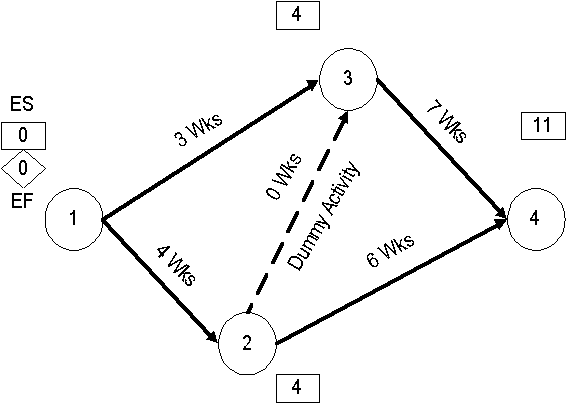
At Event 3, we have to evaluate two predecessor activities - Activity 1-3 and Activity 2-3, both of which are predecessor activities. Activity 1-3 gives us an Earliest Start of 3 weeks at Event 3. However, Activity 2-3 also has to be completed before Event 3 can begin. Along this route, the Earliest Start would be 4+0=4. The rule is to take the longer (bigger) of the two Earliest Starts. So the Earliest Start at event 3 is 4.
Similarly, at Event 4, we find we have to evaluate two predecessor activities - Activity 2-4 and Activity 3-4. Along Activity 2-4, the Earliest Start at Event 4 would be 10 wks, but along Activity 3-4, the Earliest Start at Event 4 would be 11 wks. Since 11 wks is larger than 10 wks, we select it as the Earliest Start at Event 4.We have now found the longest path through the network. It will take 11 weeks along activities 1-2, 2-3 and 3-4. This is the Critical Path.
1.5.3 The Backward Pass - Latest Finish Time Rule
To make the Backward Pass, we begin at the sink or the final event and work backwards to the first event.
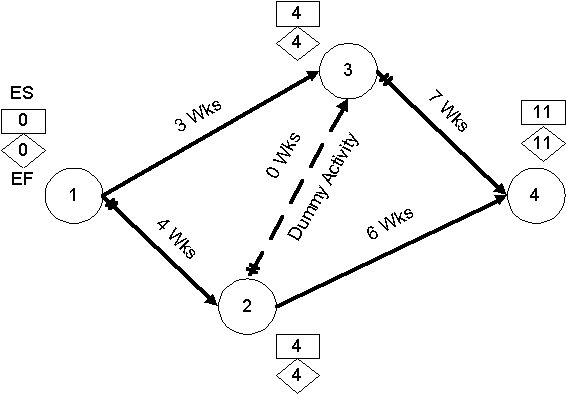
At Event 3 there is only one activity, Activity 3-4 in the backward pass, and we find that the value is 11-7 = 4 weeks. However at Event 2 we have to evaluate 2 activities, 2-3 and 2-4. We find that the backward pass through 2-4 gives us a value of 11-6 = 5 while 2-3 gives us 4-0 = 4. We take the smaller value of 4 on the backward pass.
1.5.4 Tabulation & Analysis of Activities
We are now ready to tabulate the various events and calculate the Earliest and Latest Start and Finish times. We are also now ready to compute the SLACK or TOTAL FLOAT, which is defined as the difference between the Latest Start and Earliest Start.
| event | duration(weeks) | earliest start | earliest finish | latest start | latest finish | total float |
| 1-2 | 4 | 0 | 4 | 0 | 4 | 0 |
| 2-3 | 0 | 4 | 4 | 4 | 4 | 0 |
| 3-4 | 7 | 4 | 11 | 4 | 11 | 0 |
| 1-3 | 3 | 0 | 3 | 1 | 4 | 1 |
| 2-4 | 6 | 4 | 10 | 5 | 11 | 1 |
- The Earliest Start is the value in the rectangle near the tail of each activity
- The Earliest Finish is = Earliest Start + Duration
- The Latest Finish is the value in the diamond at the head of each activity
- The Latest Start is = Latest Finish - Duration
There are two important types of Float or Slack. These are Total Float and Free Float.
TOTAL FLOAT is the spare time available when all preceding activities occur at the earliest possible times and all succeeding activities occur at the latest possible times.
- Total Float = Latest Start - Earliest Start
Activities with zero Total float are on the Critical Path
FREE FLOAT is the spare time available when all preceding activities occur at the earliest possible times and all succeeding activities occur at the earliest possible times.
When an activity has zero Total float, Free float will also be zero.
There are various other types of float (Independent, Early Free, Early Interfering, Late Free, Late Interfering), and float can also be negative. We shall not go into these situations at present for the sake of simplicity and be concerned only with Total Float for the time being.
Having computed the various parameters of each activity, we are now ready to go into the scheduling phase, using a type of bar chart known as the Gantt Chart.
There are various other types of float (Independent, Early Free, Early Interfering, Late Free, Late Interfering), and float can also be negative. We shall not go into these situations at present for the sake of simplicity and be concerned only with Total Float for the time being. Having computed the various parameters of each activity, we are now ready to go into the scheduling phase, using a type of bar chart known as the Gantt Chart.1.5.5 Scheduling of Activities Using a Gantt Chart
Once the activities are laid out along a Gantt Chart (Please see chart below), the concepts of Earliest Start & Finish, Latest Start & Finish and Float will become very obvious.
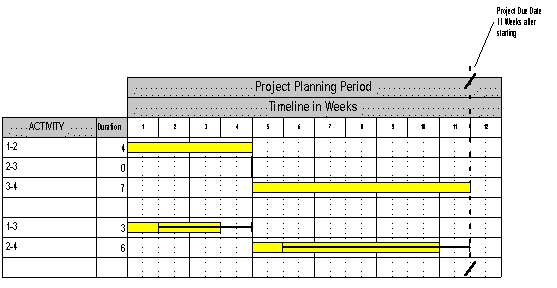
Activities 1-3 and 2-4 have total float of 1 week each, represented by the solid timeline which begins at the latest start and ends at the latest finish. The difference is the float, which gives us the flexibility to schedule the activity.
For example, we might send the staff on leave during that one week or give them some other work to do. Or we may choose to start the activity slightly later than planned, knowing that we have a week’s float in hand. We might even break the activity in the middle (if this is permitted) for a week and divert the staff for some other work, or declare a National or Festival holiday as required under the National and Festival Holidays Act.
These are some of the examples of the use of float to schedule an activity. Once all the activities that can be scheduled are scheduled to the convenience of the project, normally reflecting resource optimisation measures, we can say that the project has been scheduled.
2. Exercise
A Social Project manager is faced with a project with the following activities:
| activity-id | activity - description | duration |
| 1-2 | social work team to live in village | 5 weeks |
| 1-3 | social research team to do survey | 12 weeks |
| 3-4 | analyse results of survey | 5 weeks |
| 2-4 | establish mother & child health program | 14 weeks |
| 3-5 | establish rural credit programme | 15 weeks |
| 4-5 | carry out immunisation of under fives | 4 weeks |
- Draw the arrow diagram, using the helpful numbering of the activities, which suggests the following logic:
- Unless the Social Work team lives in the village, the Mother and Child Health Programme cannot be started due to ignorance and superstition of the villagers
- The Analysis of the survey can obviously be done only after the survey is complete.
- Until rural survey is done, the Rural Credit Programme cannot be started
- Unless Mother and Child Programme is established, the Immunisation of Under Fives cannot be started
- - Calculate the Earliest and Latest Event Times
- - Tabulate and Analyse the Activities
- - Schedule the Project Using a Gantt Chart
3. The PERT (Probabilistic) Approach
So far we have talked about projects, where there is high certainty about the outcomes of activities. In other words, the cause-effect logic is well known. This is particularly the case in Engineering projects.
However, in Research & Development projects, or in Social Projects which are defined as "Process Projects", where learning is an important outcome, the cause-effect relationship is not so well established.
In such situations, the PERT approach is useful, because it can accommodate the variation in event completion times, based on an expert’s or an expert committee’s estimates.
For each activity, three time estimates are taken
- The Most Optimistic
- The Most Likely
- The Most Pessimistic
Where te is the Expected time, to is the Optimistic time, tm is the most probable activity time and tp is the Pessimistic time.
It is not necessary to go into the theory behind the formula. It is enough to know that the weights are based on an approximation of the Beta distribution.
The Standard Deviation, which is a good measure of the variability of each activity is calculated by the rather simplified formula:
The Variance is the Square of the Standard Deviation.
4. PERT Calculations for the Social Project
In our Social Project, the Project Manager is now not so certain that each activity will be completed on the basis of the single estimate he gave. There are many assumptions involved in each estimate, and these assumptions are illustrated in the three-time estimate he would prefer to give to each activity.
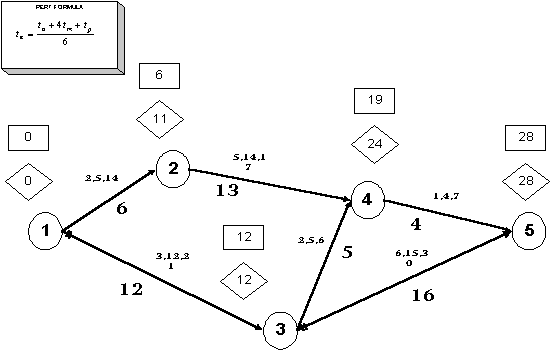
In Activity 1-3, the time estimates are 3,12 and 21. Using our PERT formula, we get:
| event | to | tm | tp | te | es | ef | ls | lf | tf | s.d. | var. |
| 1-3 | 3 | 12 | 21 | 12 | 0 | 12 | 0 | 12 | 0 | 3 | 9 |
| 3-5 | 6 | 15 | 30 | 16 | 12 | 28 | 12 | 28 | 0 | 4 | 16 |
| 1-2 | 2 | 5 | 14 | 6 | 0 | 6 | 5 | 11 | 5 | 2 | 4 |
| 2-4 | 5 | 14 | 17 | 13 | 6 | 19 | 11 | 24 | 5 | 2 | 4 |
| 3-4 | 2 | 5 | 8 | 5 | 12 | 17 | 19 | 24 | 7 | 1 | 1 |
| 4-5 | 1 | 4 | 7 | 4 | 19 | 23 | 24 | 28 | 5 | 1 | 1 |
5. Estimating Risk
Having calculated the s.d. and the Variance, we are ready to do some risk analysis. Before that we should be aware of two of the most important assumptions made by PERT.
- The Beta distribution is appropriate for calculation of activity
durations.
- Activities are independent, and the time required to complete one activity has no bearing on the completion times of it’s successor activities in the network. The validity of this assumption is questionable when we consider that in practice, many activities have dependencies.
5.1. Expected Length of a Project
PERT assumes that the expected length of a project (or a sequence of independent activities) is simply the sum of their separate expected lengths.
Thus the summation of all the te's along the critical path gives us the length of the project.
Similarly the variance of a sum of independent activity times is equal to the sum of their individual variances.
In our example, the sum of the variance of the activity times along the critical path, VT is found to be equal to (9+16) = 25.
The square root VT gives us the standard deviation of the project length. Thus, ST=Ö 25=5. The higher the standard deviation, the greater the uncertainty that the project will be completed on the due date.
Although the te's are randomly distributed, the average or expected project length Te approximately follows a Normal Distribution.
Since we have a lot of information about a Normal Distribution, we can make several statistically significant conclusions from these calculations.
A random variable drawn from a Normal Distribution has 0.68 probability of falling within one standard deviation of the distribution average. Therefore, there is a 68% chance that the actual project duration will be within one standard deviation, ST of the estimated average length of the project, te.
In our case, the te = (12+16) = 28 weeks and the ST = 5 weeks. Assuming te to be normally distributed, we can state that there is a probability of 0.68 that the project will be completed within 28 ± 5 weeks, which is to say, between 23 and 33 weeks.
Since it is known that just over 95% (.954) of the area under a Normal Distribution falls within two standard deviations, we can state that the probability that the project will be completed within 28 ± 10 is very high at 0.95.
5.2. Probability of Project Completion by Due Date
Now, although the project is estimated to be completed within 28 weeks (te=28) our Project Director would like to know what is the probability that the project might be completed within 25 weeks (i.e. Due Date or D=25).
For this calculation, we use the formula for calculating Z, the number of standard deviations that D is away from te.
By looking at the following extract from a standard normal table, we see that the probability associated with a Z of -0.6 is 0.274. This means that the chance of the project being completed within 25 weeks, instead of the expected 28 weeks is about 2 out of 7. Not very encouraging.
On the other hand, the probability that the project will be completed within 33 weeks is calculated as follows:
The probability associated with Z= +1 is 0.84134. This is a strong probability, and indicates that the odds are 16 to 3 that the project will be completed by the due date.
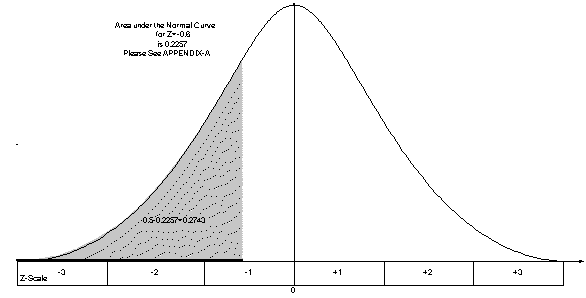
If the probability of an event is p, the odds for its occurrence are a to b, where:
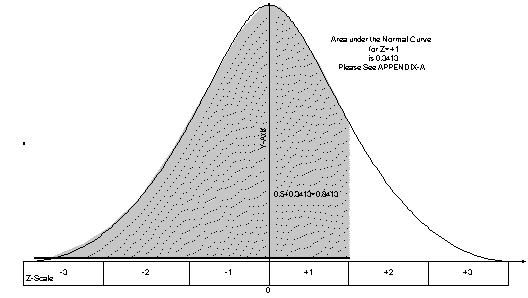
Select Bibliography
Wiest, Jerome D., and Levy, Ferdinand K., A Management Guide to PERT/CPM, New Delhi: Prentice-Hall of India Private Limited, 1974
Render, Barry and Stair Jr., Ralph M. - Quantitative Analysis for Management, Massachusetts: Allyn & Bacon Inc., 1982, pp. 525-563
Freund, John E., Modern Elementary Statistics, New Delhi: Prentice-Hall of India Private Limited, 1979

